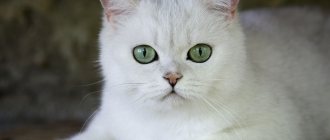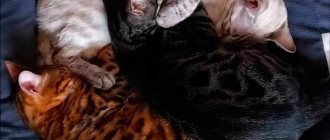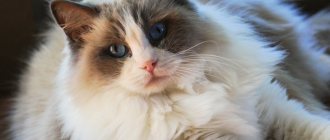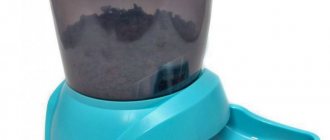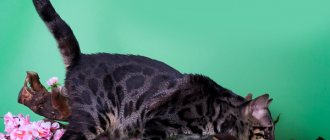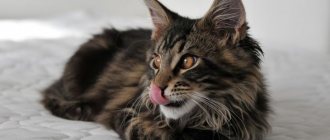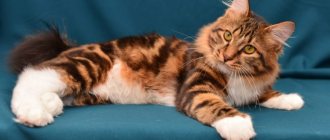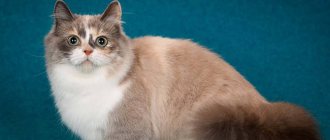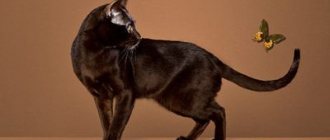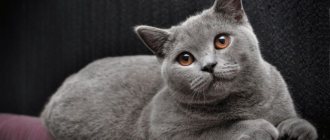Korat. One of the oldest cat breeds in Siam, it has long been endemic to its country and was considered a gift that will bring happiness and good luck. Kittens of the silver breed were never bought; they were usually presented as a gift to an important person, newlyweds, and as a wish for all the best on a holiday.
The blue-gray cat breed came to Europe and then to America thanks to the great wars. Since 1965, the breed began the path of obtaining an international standard and admission to all exhibitions and titles, which ended in 1982 with registration with the International Federation.
Korat
Now the breed is alive precisely thanks to its distribution in the USA, because you can easily buy a Korat kitten only in this country.
As for the appearance of the breed, there are a number of features:
- The cat is small, an adult does not exceed 5 kilograms, although most often these are cats 3-3.5 kilograms. Females are always smaller and more graceful than males.
- The cat's muzzle is wedge-shaped and, from the front, looks like a heart.
- The breed's fur has no undercoat, is short, lies close to the body and is very delicate to the touch.
- The most valuable shades of the iris are green, although the shade may change until the cat reaches 4 years of age.
- The main color is gray, but the more silver in the coat, the more valuable the kitten. The ideal show animal's coat color should be solid ticked silver blue.
- All the exterior features of the breed are fully formed by the age of 4.
Breeds of gray cats with photos and descriptions
There are many cat breeds that are gray in color. Below are descriptions of the main ones, with photographs and a brief description. The names of some breeds may differ in different sources (for example, the Fold is often called the Scottish Fold).
It should be understood that there are many more different breeds in the world that have a noble gray color. We will briefly look at some of the features and history of only a few varieties that have gained worldwide recognition and distribution.
Arkhangelskaya
The breed of these graceful gray beauties was never named. Already in the 17th-19th centuries, these cats were known, in addition to Russia, in England, Spain, Germany and Scandinavia. That's why there was confusion with the names. Maltese, Russian, Arkhangelsk - this is an incomplete list of names based on the supposed place of origin that these noble beauties were called.
Relatively recently, having carefully studied the history of the breed’s distribution, scientists have established that the animal’s homeland is the northern regions of Russia, namely the Arkhangelsk province. This is the cat’s natural habitat; they came to other places on our planet thanks to English sailors, who, as is known, were among the first Europeans to begin trading with Russia through Arkhangelsk.
The sailors took the animal onto the ship, seeing it as an excellent rat catcher. And once in England, the cat won the hearts of the local aristocracy with its appearance. The innate grace, subtle beautiful features, and ideal quality of wool, characteristic of the north, could not leave connoisseurs indifferent. In addition, a calm, restrained disposition suited the court in conservative England.
Until 1912, the breed was called Arkhangelsk Blue. Then, until 1939, it was called foreign blue, then it began to be officially called Russian blue, which is what it is called to this day.
Important! The Arkhangelsk or Russian Blue should have a uniform gray or blue-gray coat with a silver tint. Any spots or medallions are considered a defect in the breed.
It reaches a height of 25 cm and weighs 3-7 kg. It has a fit, lean body; excessive density is considered not to meet breed standards. Long slender legs have well-developed muscles. The skull is flat, elongated, and has a classic profile. According to breed standards, a cat must have green almond-shaped eyes.
The wool is of excellent quality, thick, dense and soft - another distinctive feature of the animal. At dusk, the color of the coat makes its owner completely invisible against the background of the environment, which is the most valuable quality for a real hunter.
He has a unique combination of innate aristocracy and frisky playfulness. He loves communication, but does not impose it, and does not make any noise or fuss at all. Treats all household members equally well. Loves praise, can allow himself to be petted, but cannot stand being cuddled and lisped.
He never shows aggression towards people; he is tougher towards dogs. Their fur does not shed, the cats are clean themselves and are very demanding about the cleanliness of the room. The Arkhangelsk Blue can be recommended to those who are looking for the most hypoallergenic cat.
Chartreuse
France is considered the birthplace of the breed. Mentions of it can be found in sources from the 14th century. Cats were bred by Carthusian monks. The animals coped well with the dominance of mice in the monasteries. There is another version, quite unpleasant, of why the monks fell in love with the Chartreuses so much. The fact is that the order’s charter did not consider killing cats a sin, and the monks bred the breed for meat and skins. Chartreuse wool is of excellent quality. There is such a version of the origin of this species:
The ancestors of the Chartreuse are Siberian cats, which came to France thanks to the Crusaders. Before this, the Siberian cat allegedly reached through Central Asia, Iran and Syria to the territory of modern Turkey, where it joined the army of Christ. And the Siberian cat, in turn, was a descendant of the Pallas cat and the Egyptian cat. Later, when the crusaders returned home, new companions arrived with them on ships - the future Chartreuses.
The breed standard was approved in 1934. In the late 1960s, the cat ended up in the United States. Soon the breed gained worldwide recognition. Some reputable clubs are of the opinion that the British Shorthair also belongs to the Chartreuse breed. The reason for this was the unification of the British Shorthair and Chartreux into one breed by the International Cat Federation in 1970. Seven years later, the breeds were again recognized as separate, but some confusion remains to this day.
True chartreuse is blue in color. Only blue, no shades! The cat is quite large, has a natural, non-hybrid appearance. Very playful. Eyes change color with age: from blue in kittens, gray in a young cat, to orange in a mature cat.
The head is round in front, elongated from the side. Large eyes, with an attentive, studying gaze. Strong back of the head and neck. Powerful body with developed muscles. Males reach more than 7 kg of weight, cats up to four. They have a developed sternum and a strong back.
Did you know? Charles de Gaulle had a Chartreuse, he called the breed “Carthusian”.
The forelimbs seem stronger than the hind limbs. Thick movable tail. The wool has two layers and has an undercoat that protects well from water. The color can be any shade of blue, but spots on the fur or skin, various kinds of medallions are a defect in the breed.
Has an unobtrusive character. He is very attached to his owner and loves his company. Can accompany the owner everywhere until asked to leave him alone. An understanding animal will do this right away, without any offense.
Chartreuse is a born hunter. You should remember this if you have, for example, a guinea pig at home. He does not play with the victim; the destruction of prey is inherent in him at the genetic level. At the same time, the cat, thanks to its innate ingenuity, sensibly assesses its own strengths and never bullies itself unnecessarily. Perfect for families and single people.
Important! British Shorthairs that do not meet breed standards are often passed off as Chartreuse. Keep this in mind and try not to buy a cat from someone else.
Nibelung
The breed has Russian roots. She is a descendant of the Russian Blue. Received recognition in the 80s of the XX century. At the end of the 19th century, long-haired babies began to appear among Russian Blue Shorthair kittens. Thus, a new breed appeared naturally.
Cats were even exhibited at competitions, but they were not deliberately selected for, although the population of the breed was increasing. Krasnoyarsk is considered the small homeland of the Nibelungs. The breed received recognition in the USA. From 1987 to 2008, all leading American felinological associations, and after them international ones, officially recognized Nibelung cats.
The animal is very beautiful and has extraordinary grace. It differs from the Russian Blue in the length and structure of its coat. Their coat is soft and has a sponge-like tactile sensation. The color of the coat is solid gray, in the sun it shimmers with silver. It has an elongated body with developed muscles. Long limbs and tail. Big eyes and ears. The nose is gray with a blue tint, pink pads on the paws.
The character is kind and flexible. Among the household members, she chooses her own owner, although she treats all family members well. A true intellectual in relationships, unobtrusive and not demanding special attention.
He doesn’t really like being alone, he likes the company of family members. But he treats strangers with caution. They are absolutely not aggressive, I can even be friends with dogs. If you want to adopt a calm animal with a kind, cheerful disposition, the Nibelung is for you.
Korat
The history of many popular cat breeds today originates from ancient Siam, now Thailand. The Korat is one such breed. They are very graceful and beautiful. It is believed that their small homeland is the Thai province of Korat, which is reflected in the name of the breed. The name of the breed was given by the King of Siam, Rama V, when he was presented with an animal native to the highland region of the state.
These Thais bring good luck to the home, which is why in their homeland they are literally called “the bringers of happiness.” In Thailand, it is not customary to buy them, only to give or receive them as a gift. These cats are given to young people as wedding gifts. It is believed that along with the korat, good luck and prosperity come to the house, and all negativity goes away. Europeans learned about this breed only at the end of the 19th century.
The animals came to the USA in the late fifties of the 20th century. The cat ended up in the New World thanks to Jean Johnson, the wife of an American military man who served in Thailand and received the animal as a gift. In 1965, American associations officially recognized the Korat breed.
Cat clubs in Great Britain officially recognized the breed in 1975. In 1982, Korat received official registration from the International Federation. Currently, most representatives of this breed live in the United States.
A characteristic feature of the breed is its blue color. It has a lot of shades, but silver is most valued. The more silvery a cat is, the higher its value. Eye color is allowed from emerald to various shades of orange. The eyes are large and fully reveal their color after three years.
The cat is compact in size, although quite strong. The weight of an adult animal is from 2.5 to 5 kg. Males are larger than females. The animal has long legs. The head looks like a heart, the ears are large. The nose is divided in two in the middle. All these external signs are fully formed only after four years.
Very playful and inquisitive. The kitten will not leave you for a minute. He becomes very attached to his owner, following on his heels. He is friendly with the rest of the household, but his attitude towards the owner will be special.
Korats are extremely jealous; it is not recommended to keep them together with other species or even with fellow cats. Less noisy than their cousins - Siamese cats. They have a sharp mind and ingenuity, an ideal exhibition option, thanks to their natural endurance and restraint.
British blue
Britons are famous gray cats with eyes of every shade of yellow. One of the most popular blue breeds in the world. Eye colors range from copper to lemon and various shades of orange.
Did you know? In England there is a legend that the British Shorthaired Blue cat is a descendant of the Cheshire cat.
The blue coat color of the British breed is extremely popular in the world, although representatives of the breed can have more than 50 different coat colors.
The ancestors of modern blue British cats were Persians and English domestic cats. The breed appeared in the 19th century and soon received official recognition. Life expectancy is up to 15 years.
The Briton, which meets breed standards, has a very dense, fluffy and soft coat. The eyes, as already mentioned, are all shades of yellow, round in shape. The coat has an even, continuous color along the entire length of the hair.
The body is strong, with well-developed muscles. Short legs, firmly planted on the ground. Thick tail, with dense, not very fluffy hair. The head is quite large, round in shape, sits tightly on a developed neck and an equally developed chest. These cats look like bear cubs and look very cute.
The British are a natural breed and therefore enjoy good health. Animals weigh 4-6 kg. Cats are noticeably smaller than cats. They have a friendly, sociable disposition. At the same time, the animal is usually restrained and quite balanced mentally.
Important! There is a fold-eared variety of the British. According to the standards, their ears should be firmly pressed to their head. There are also cats of this breed with long hair.
Curiosity, playfulness and activity are qualities inherent in real British people. Another characteristic feature of the breed is that cats are sensitive to the psychological situation in the house, and it has a strong influence on them. If there is an unhealthy atmosphere in the family, the animal will grow up nervous and unbalanced.
At three years old, the character of the animal is fully formed. Cats are distinguished by their cleanliness and good disposition towards all family members. They get along well in a family with other animals, but distance themselves from strangers, even seeing that they are friends of the owners.
They do not recognize inappropriate familiarity, therefore they do not like to be squeezed and often do not respond to “kitty-kitty”, only to a nickname. Even the hungry will not ask to feed him. Most likely, the animal will sit next to its plate and wait.
In case of rough treatment by the owners, he becomes aggressive and completely uncontrollable, as if showing that he is a proud, independent animal of high origin, and requires an appropriate attitude towards himself.
American Curl
The beginning of the 80s of the XX century - it was from that time that the history of the American Curl breed should be counted. The history of the appearance of the breed is quite interesting, rich in drama; we will dwell only on some points.
In 1981, a certain Joe Roog accidentally discovered two kittens with unusual ears under the door of his own house. His wife, Grace, persuaded her husband to adopt the kittens. It turned out that they were two girls, they named them Shulamith and Panda. In addition to their childish charm, cats had a characteristic, until then unknown feature - curled ears.
Later, Panda became the victim of an accident, and Shulamith remained to live in the family of Joe, who later became the founder of the breed. In 1983, Grace's assumptions were confirmed that curled ears are a gene mutation in Shulamith, and this is a dominant gene. Subsequent matings of the descendants of Shulamith and domestic cats strengthened the characteristic feature, and soon the American Curl breed was officially recognized.
The weight of an adult cat is 5-7 kg, a female cat is 3-5. According to the standards, the American Curl must have a cone-shaped head with sloping contours. The cat is quite broad-browed with a straight nose, a massive rounded nape, smoothly flowing into a strong neck. Correct bite, massive chin.
Strong body with developed muscles. The cat is slender, the sternum is quite wide. The limbs are of medium size, the length of the tail is the same as the body. There are short-haired and long-haired Curls.
Did you know? Biologically speaking, a cat's brain is more similar to a human's than a dog's.
A characteristic feature of the breed is the ears. The shells have an unusual curved shape. The curl's ears, unlike the ears of its fellows, have hard cartilage, which is a consequence of a natural mutation.
The inclination of the shell can be different, but the tip of the ear must certainly be directed forward. Due to the bending of the cartilage, the fur in the ear looks fan-shaped. The size of the ear is of secondary importance, the main thing is the bend.
Too much curvature of the ear, soft or deformed cartilage, pointed or erect ears are signs that do not qualify the American Curl for breeding.
American Curls are always active and cheerful. They have excellent learning abilities. Truly loyal to their owner, which is not so common among cats. They love to communicate with people, especially with children.
They have a balanced psyche and restraint. After observing curls for a long time, one can conclude that they think about their every action, even in small things. They understand everything perfectly, and verbal suggestion is enough for them. Under no circumstances should you start screaming; you may completely lose contact with the animal.
The more time you devote to your pet, the more it will surprise you, in a good way. With proper treatment and upbringing, he can become not just a companion, but a completely conscious friend.
The color of Curls has quite a wide variety. Gray and lilac colors, as well as various tabby variants, will appeal to lovers of blue color. A distinctive feature of the breed is its ears of an unusual shape, with the tops turned out, with fluffy hairs inside.
Cat fur can be long or semi-long. The excellent quality of the coat allows the animal to look great, but requires very careful care. Curls need to be brushed twice a day. They have a beautiful fluffy tail and the same frill collar. They have a playful character and good health, which, with proper care and nutrition, is observed in animals even in old age.
It will be useful for you to learn how to care for long-haired cats.
Scottish fold
The young breed is a mutation of the British Shorthair. Received official recognition in 1964. Since then, its popularity around the world has been steadily growing. It is believed that the breed was formed due to random mutation, and not targeted selection. An animal with floppy ears was born in Scotland. Later, breeders began to consolidate it by mating with the British Shorthair and a simple domestic cat in England and the American Shorthair in the USA.
The animal is of medium size, with a round head. A characteristic feature of the breed is the ear folds, due to which the ear is tilted towards the eye. Due to the density and softness of the coat, it resembles a teddy bear. Adding to the similarity are small ears, rounded and lying tightly on the head.
Important! A gene mutation is the reason for the extraordinary appearance of the Scottish Fold cat. If the ears do not fall off with age and remain straight, the cats are called straight-eared Scots.
Round large eyes in color. They often have various shades of copper, but there are also blue, which, along with eyes of different colors, is allowed by the standards for some colors.
The body is medium in size, with a less massive base than the British. The tail is long and flexible, gradually tapering.
There are two types of Scots:
- SFS (scottish fold shorthair) - Scots with a plush coat;
- SFL (Scottish fold longhair) - longhaired.
- There are many different colors of the Scottish Fold: tabby, double color, van, etc.
The Scots are similar in character to their closest relatives, the British.
Active, kind and friendly. They react normally to representatives of other species. They love to play with children, especially if you don’t abuse their affection and don’t pick them up. They have good mental and physical health. Did you know? There are about half a billion domestic cats living in the world. Approximately 40 breeds are internationally recognized.
Chartreuse (Carthusian cat)
Legend has it that the breed arrived in Persia from France along with preachers, and the countries of secondary distribution (Syria, Turkey, Iran) simply fell in love with the breed of cats with a stuffed gray coat and round cheeks for their talent to catch rodents in countless numbers. The breed received a modern standard in 1934, at which time the family tree of the breed was revealed. It is believed that the ancestors of the gray cat breed were the Pallas' cat and the Egyptian Mau, which later came to Siberia and formed the breed of Siberian cats, and later, through medieval selection, the stuffed, fur-bearing gray Chantreuse was bred. Gray cats were considered the only “non-messengers” of the devil and they were bred as fur-bearing edible rat catchers - not a cat, but a “universal soldier” for all occasions.
INTERESTING: the breed is often confused with the British Shorthair, although historically and legally these are two different breeds. You can distinguish a true Chartreuse by the evolution of the color of the iris - kittens have blue eyes, by adolescence they turn gray and in adulthood either a dark orange or a bright yellow tint appears.
The blue color in the color is uniform, deep, and goes very beautifully with the colors of the iris: dark orange or bright yellow. Gray is the only acceptable color, even the pads on the paws and nose are gray-blue, shades are not allowed.
The character of the breed is truly oriental - the cat is wary of strangers, and loves everyone in the family, but is not greedy for tenderness. This is a real cat, which is more on its own than the rest of the family.
The gray cat of your dreams
When choosing a gray (blue) furry friend for yourself, study different breeds, because representatives of each have certain personal characteristics. However, when deciding which cat suits your lifestyle, you should consider that a particular animal will have its own habits and temperament.
It is equally important to understand how much time you are willing to devote to caring for your pet so that its beautiful gray “fur coat” remains healthy throughout the cat’s life.
Based on materials from cats.lovetoknow.com
Russian blue cat
The long-lived, compact and very quiet Russian Blue cat breed originated in the Arkhangelsk province of Tsarist Russia and is still very popular throughout the world. The coat of the Russian Blue is short, but very dense and has a beautiful gray-blue color without any spots or marks. Large green irises add bonuses to the uniform plush coat.
The basis of exhibition competition for the breed is the quality and structure of the coat. It is this that serves as the main criterion for admission to exhibitions, and only then experts look at the general exterior of the animal.
Many owners note the independent character of the Russian Blue cat breed. Yes, the pet is affectionate, but if she doesn’t want contact, then you won’t be able to pet the cat. He loves to choose his owner and, as a result, the rest of the household may not wait at all for the indulgence of this graceful gray cat.
About color
The solid gray uniform color of cats is usually called blue. This color symbolizes the intangible, spiritual world, and blue cats are considered its guides. They are recognized as the best healers and protectors of humans, bringing love and peace to the home. This shade of fur in a cat is determined by the gene that carries the black color B, diluted by the recessive allele d. That is, the “blue” color is essentially a lightened charcoal color.
There are many variations in the genotype of gray cats, it depends on the combination of genes B and d in a recessive or dominant, homo- or heterozygous form. That is why there are such gray colors as chinchilla, mackerel, tabby, solid, smoky, agouti. It all depends on the degree to which each hair is painted black and the alternation of charcoal and white stripes on it.
Also read: TOP 10 evil cat breeds.
Nibelung
The beautiful name of the breed is fully justified by its appearance. The semi-longhaired cat captivates with its manners and grace.
The gray cat breed began its existence and career in worldwide cat fanciers in the 1980s, when the first mixed litters were obtained between a Russian Blue cat and a Black Shorthair cat. Crossbreeding gave impetus to recessive genes and by 1987 Cora Cobb had achieved a standard for a new breed, which, by the way, differed from the Russian Blue only in long hair.
The name of the breed was also given by Cora Cobb, who can safely be called the mother of all Nibelungs. The literal translation of the name is “child of the mists,” and this is very accurate, since the edges of the hairs of gray wool create a kind of haze around the animal in the light.
INTERESTING: Nibelungs inherited a quiet voice from their “grandmother” Russian Blue breed. It is almost impossible to hear the breed meow; the cat will convey all its demands to the owner through sign language and plastic movements, and only as a last resort will it “say” something.
The obligatory color of the breed is gray; tipping is allowed, but not encouraged. The irises of the eyes should be any shade of green. In males, a small mane is allowed; in females, its volume should be minimal. The fur coat is soft to the touch, the guard hair is longer on the pants and back. In summer the coat becomes shorter than in winter.
How gray cats appear, a little genetics
Various combinations of dominant and recessive genes are the main factors determining the color of a particular cat breed. The dominant gene responsible for black color and white, as a recessive one - this is exactly what the gray color of cats looks like from the point of view of genetics.
It should be said that the amount of black pigment is the same in both gray cats and those that have a darker color. The difference lies in how the pigment is distributed. Black cats have uniform pigmentation, while gray cats have dyes located in the middle of the hair.
Light passing through the outer layer of the hair is refracted and gives this shade at the output. The amount of pigment also affects the intensity of the color.
Did you know? The first official British cat show took place in London on July 13, 1871.
Sometimes there is a gene mutation in which the ends of the hair are white, and the black pigment is concentrated in the lower part of the hair. There are also the opposite cases, when the roots have white pigmentation, and the top of the hair is black. This coat looks like it is covered with frost.
In general, in professional circles, the color of wool of gray shades is called blue, in some cases blue. Breeders have been trying for many years to create a breed of cats that are completely gray with a perfect blue tint. The main quality of this color is the complete absence of red (red) pigment.
But the gray or blue color also has a warm shade. It can be found in animals that have the red gene as a dominant one. This color is called lilac, it is extremely rare and is not allowed for some breeds. “Shaded gray” is a hair color that is one-third gray and the rest is white. Chinchilla color - an eighth of the hair is gray, the rest is white.
Learn about the characteristics of ginger and tabby cats.
Many native breeds reject gray coat color. When trying to fix this color in Siberian cats, their fur changed not only its color. The structure of the wool began to change, and they decided to stop work in this direction.
British shorthair cat
When a British Shorthair cat climbs onto your lap, you immediately feel the weight, the warmth, and the incredibly stuffed plush cat dough that you want to knead and squeeze. Yes, the breed has many shades, for some of them there is a real war among breeders, but the classic color of the breed is uniform gray, without stripes or stains.
The ancestors of the breed were Roman cats, rat catchers from ships, which the warriors of Rome brought with them to the territory of the modern Kingdom. But medieval views on the cat community did their job and until the 19th century no one thought about at least some kind of breeding, nevertheless, the beginnings of the breed were already there and a sufficient population of plush cats with abundant undercoat and a purely English, imperturbable character had formed.
The development of the breed, like many other English breeds, was influenced by the very first professional cat show in 1871. The next morning, the cats woke up not just as functional barn animals, but as interior decorations, popular pets and family friends.
Now the British breed has already split into two branches, gained popularity around the world and has acquired many shades of coat, but the historical color of the breed, gray, is still popular and is often presented at exhibitions.
Temperament and behavior
Gray cats have the appearance of aristocrats and their behavior is appropriate. Character independent, proud. At home they behave like owners. From childhood, calmness and nobility prevail in temperament.
British shorthair cat
Anger is not typical for animals. Some breeds have a playful nature, while others, on the contrary, prefer solitude. Blue cats are smart and curious. Loyal to their owners, they love to bask in their arms. Most breeds tolerate long periods of absence from people. At the same time, they don’t make a mess in the apartment.
Scottish fold cat
The large gray cat breed, originally from Great Britain, is a young breed, but its worldwide fame and popularity can no longer be denied.
The breed was formed in the 1960s and inherited from the British breed a thick coat and a phlegmatic character. The only serious difference is, perhaps, in the shape of the ears; otherwise the breeds are very similar.
The Scottish Fold is friendly and trouble-free. The owner needs to go to work - let him go, the owner is at home all day - that’s also normal. Of course, a cat loves its family, but it is so self-sufficient that the constant presence of a person will not make it happier; it is enough to pay attention to the cat in the evenings and a little in the morning so that the animal does not go wild in conditions of complete loneliness.
INTERESTING: the breed loves to get into a meerkat pose in moments of increased interest. The breed also does not like heights, which is very important if you have a rich interior and many shelves with souvenirs and interior decorations - all this will remain untouched, because this breed only needs to climb onto a soft sofa and is not at all interested in jumping on curtains and cabinets.
The breed's coat can be any color, but gray is the classic color that comes from the British Shorthair breed.
Nuances of care
To maintain the beauty of a gray fur coat, it is not recommended to walk cats in sunny and rainy weather, since ultraviolet radiation and precipitation lead to the appearance of red spots on the fur.
Caring for blue cats is no different from caring for pets of other colors. The choice of products and tools depends on the length of the coat and the presence of undercoat.
Cats themselves are clean animals and do not need frequent washing. If the pet is heavily soiled, place it in a basin of water, lather the fur with hypoallergenic shampoo and rinse off the foam with running water.
During shedding season, cats with undercoat should be brushed daily. The rest of the time, once a week is enough. To do this, use a furminator or a comb with fine teeth. The procedure begins with the scruff of the neck, gradually moving towards the tail according to the growth of the fur.
Long fur needs more attention. This rule especially applies to Persians. Their soft, airy fur is prone to forming tangles, which are very difficult to untangle. It is recommended to use a slicker brush for combing. If the tangle cannot be untangled, it is cut off with a trimmer or scissors.
Advice. Corn or potato starch will help make combing easier. Rub the wool with it and carefully comb it with a comb.
To clean the ears, you can use mineral oil or boric alcohol, as well as any products from Linnek marked for cats: ProVET, Nutri-Vet Ear Cleanse, TRIXIE Ear Care, Dr. Clauders Ohrenpflege. Dirt and earwax will be removed with a cotton pad; ear swabs cannot be used.
Accumulations in the corners of the eyes are wiped with a cotton pad dipped in tea leaves or warm boiled water.
The claws are trimmed as they grow with a special nail clipper, taking care not to damage the blood vessels. Animals do not like this procedure, so use distracting maneuvers. Ask someone in your household to hold a brush with feathers or a favorite toy in front of the cat's eyes.
Characteristic diseases
Breeds with blue hair are characterized by strong immunity and the absence of serious genetic pathologies. Except that the British and Scots are prone to cardiovascular diseases, and the Persians are prone to pathologies of the kidneys and retina.
Purebred animals rarely suffer from infectious diseases and are not afraid of frost. Nutrition should be balanced. Food can be natural, but without salt and spices. Premium class products are suitable for industrial feed.
Persian cat
The Persian breed is a pet that will delight your guests, but require daily care from you, just like a small child. The most common colors are smoky gray and all shades of peach.
The main problem of the breed is not even the upturned muzzle, which the owner has to wash every morning and evening, but the fluffy coat with significant undercoat and thin airy long main hair, which tends to matt into a dense tangle.
The breed has a very complex character. These cats were not bred to be outdoor mousers, they were originally domestic ornamental cats. Likewise, the modern Persian is sometimes ready to play with wind-up mice, but in general he is a calm cat, who will lie on a soft pillow next to him with great joy, rather than ask to sit on his lap or start chasing balls around the apartment.
The breed is also very attached to its owner and literally looks into the mouth, and if the cat is offended by something, then this becomes a big problem - pranks to spite the offender will turn life into a small war on the territory of a particular house. It is precisely because of this difficult character that the Persian cat breed is recommended for calm families with teenage children, because if the baby offends the cat, the whole family will take the rap.
Signs and superstitions
Gray cats are considered mysterious and mystical creatures and for a long time there have been many signs and superstitions about them:
- If such an animal crosses the road, there is no need to return, but just say the “magic words” - “happy path from the gray cat.”
- The gray pet itself coming into the house will bring peace, prosperity, and remove the evil eye and damage from the home.
- A gray cat living in the house protects the family from scandals and squabbles.
- If you stroke a gray cat early in the morning, immediately after waking up, the charge of positive energy will be enough for a person to last the whole day.
- If something doesn’t work out in the house, then you need to bring a gray cat into it and settle it - he will be able to come to an agreement with the brownie.
- An animal with “blue” fur attracts money into the house.
- If such a cat runs away from home or, even worse, is kicked out, then this is a sign of impending trouble.
We recommend reading the article about signs about gray cats.
1111
Egyptian Mau
The breed can be called the mother of all cats - wild and domestic, because the cats of Africa spread across the earth along with humans, wild and domesticated, forming many indigenous breeds with incredible evolutionary and mutational characteristics. Of course, the ancient Egyptian Mau was a little different than the modern one, but it makes no sense to argue that the breed has an ancient history, because images of thin, stately cats are on all Egyptian frescoes, and there are mentions in many ancient papyri. Even the cult of the goddess Bast is evidence of ancient origin.
The modern Egyptian Mau received the TICA standard in 1988, but has not yet reached universal distribution. The point is not in problematic content or bad character, but in the fact that, like many aboriginal breeds, the Mau for a long time had conventional outlines of the exterior and was deprived of a controlled gene pool. In this regard, there are now very few nurseries and breeders who are able to adhere to targeted selection. American breeders have achieved success, but they do not want to involve less successful European felinologists in replenishing the population.
However, the Egyptian gray cat breed standard specifies three colors that breeders should strive for when culling litters:
- Smoky - from black to dark gray, the points are always visible in contrast due to the presence of a silvery undercoat. Hair ticking is minimal.
- Silver – can vary from light to gray. The points correspond to the shade and range from black to dark gray. The neck and chin may have white fuzz.
- Bronze – creamy milky colors with dark brown points. It is found relatively less frequently than the first two, but is not inferior in beauty.
Features of maintenance and care
Breeds with a grayish color are characterized by strong immunity. Animals rarely get sick and tolerate low temperatures well. The diet should be balanced and low in iodine. Your pet can be given homemade food (that is, natural food, not table scraps) or dry and wet food. Vaccinations are a must. Don’t forget to clean your ears with cotton swabs, your teeth with a special paste, and trim your nails with tweezers as they grow.
Our reader's Scottish Fold named Plyushka
In order for the coat to be beautiful (this is important when participating in exhibitions), the pet needs to be walked less often in sunny, rainy, or snowy weather. These weather conditions lead to unwanted red spots. With proper care, gray cats live fourteen to sixteen years. Read about the life expectancy of cats on our portal.
Ocicat
The name of the breed is a reference to ocelots, but in fact, a young breed of blue-gray cats was developed from Abyssinian, Siamese and American Shorthair cats. The experiment was successful and the world saw a beautiful cat with a color like a wild ocelot, but gentle habits and a great love for her family.
A big plus of the breed is its great attachment to home and habits similar to those of a dog. If you take up raising and training a kitten, then walking on a harness and playing with a ball can become your constant entertainment with your pet.
The breed's disadvantages are associated with recessive genetic diseases that have accumulated as a result of selection. Most of them are inherited from Siamese blood and are complicated by the fact that the cat may not get sick for some time, but under a number of circumstances, the hereditary disease can “wake up” and the cat will die due to the transience of the disease.
The breed is not picky when it comes to grooming, but its teeth require especially close care – the enamel is prone to destruction and it’s not worth leaving plaque on the furry’s teeth.
The most common colors: brown and chocolate shades, lilac, blue and all pairs with blue from chocolate-silver to blue-silver. The hair is always ticked, and the markings on the body vary in saturation depending on where they are located.
Gray cats are not uncommon
Gray color, also called blue, is not uncommon in the cat community. In addition to pure gray, there are options with a variety of patterns: tabby, calico, tortoiseshell, etc. Of course, representatives of some breeds are only gray (for example, Russian Blue), which creates the impression that such cats are rare, although in fact gray wool is quite common. .
